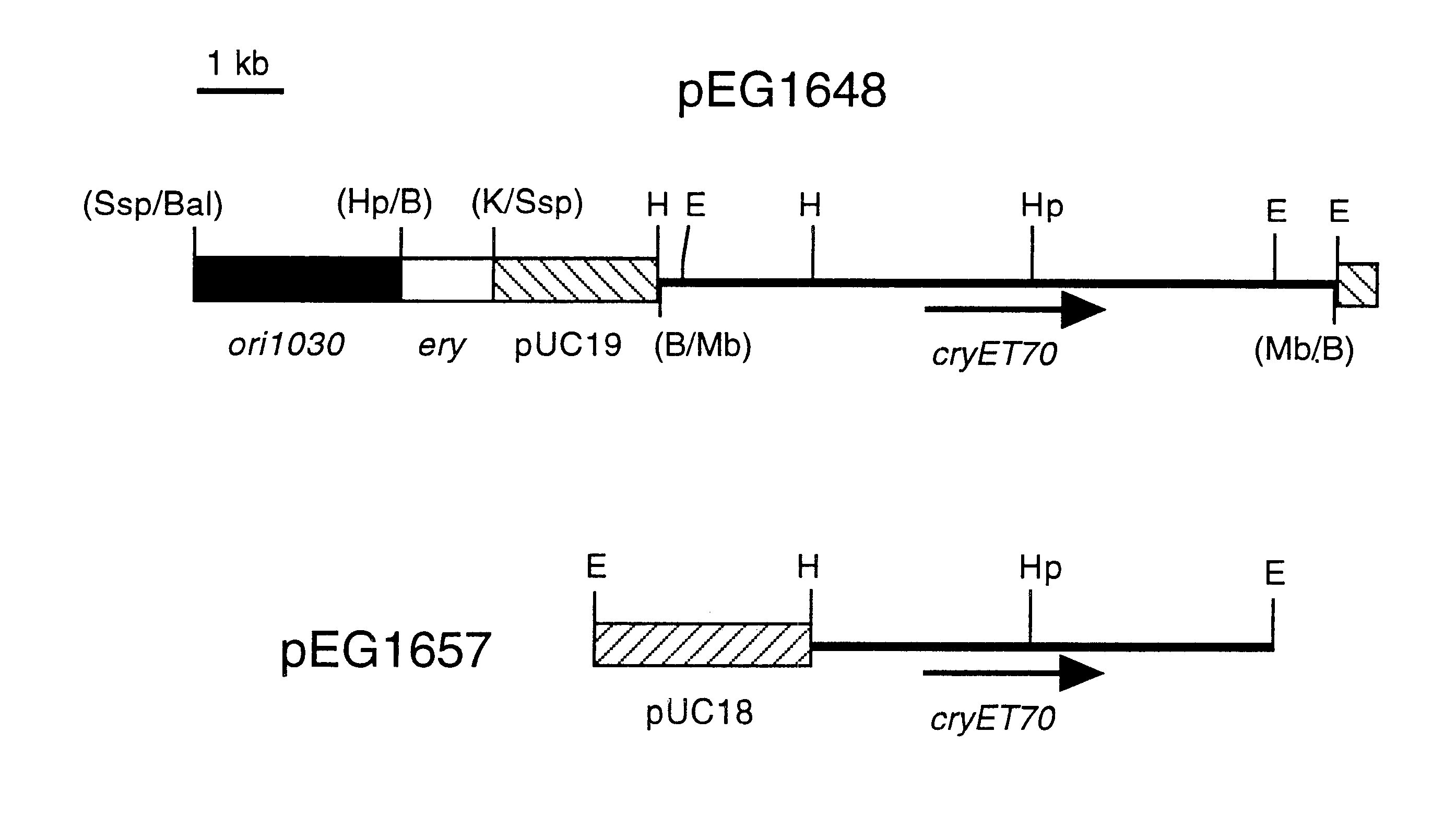Polypeptide compositions toxic to diabrotic insects, and methods of use
a diabrotic insect and polypeptide technology, applied in the field of molecular biology, can solve the problems of insect death, insect feeding stoppage, insect toxic crystal proteins, etc., and achieve the effect of being ready to stor
- Summary
- Abstract
- Description
- Claims
- Application Information
AI Technical Summary
Benefits of technology
Problems solved by technology
Method used
Image
Examples
example 1
5.1 Example 1
Isolation of B. Thuringiensis EG4140
Crop dust samples were obtained from various sources throughout the U.S. and abroad, typically grain storage facilities. The crop dust samples were treated and spread on agar plates to isolate individual Bacillus-type colonies as described (Donovan et al., 1992). EG4140 is a wild-type B thuringiensis strain isolated from a crop dust sample from Pennsylvania. Phase contrast microscopy was used to visually examine the morphology of parasporal crystals produced by the bacterial colonies from this crop dust. The colony designated PG4140 contained endospores and crystalline inclusions of a unique morphology resembling spindles. The complement of native plasmids contained within isolated B. thuringiensis EG4140 was determined by modified Eckhardt agarose gel electrophoresis as described by Gonzalez et al. (1982). The pattern of native plasmids did not correspond to patterns of typical known serovars (Gonzalez and Carlton, 1984). The plasmid...
example 2
5.2 Example 2
Bioassay Evaluation of B. Thuringiensis Strains for Toxicity Towards Coleopteran Insects
A three-tiered bioassay scheme was adopted to identify B. thuringiensis strains with toxicity towards larvae of the coleopteran insect Diabrotica virgifera virgifera (Western corn rootworm, WCRW). Because WCRW larvae are delicate, bioassays with this insect are time-consuming and frequently result in high control mortalities. To limit the number of WCRW bioassays that needed to be performed, coleopteran-toxic B. thuringiensis strains were first identified by performing bioassay screens against larvae of the Colorado potato beetle (Leptinotarsa decemlineata, CPB), an insect that shows greater sensitivity than WCRW to coleopteran-toxic B. thuringiensis Cry proteins. Strains with CPB-toxicity were further prioritized by performing bioassay screens against larvae of the coleopteran insect Diabrotica undecempunctat howardii (Southern corn rootworm, SCRW), a closely related species of root...
example 3
5.3 Example 3
Characterization of the CryET70 Polypeptide
EG4140 was grown in C2 (Donovan et al., 1988) medium for four days at 25.degree. C. during which time the culture grew to stationary phase, sporulated and lysed, thus releasing the protein inclusions into the medium. Two hundred microliters of the culture were added to one milliliter of 1M NaCl, 1 mM EDTA, pH 8 and centrifuged to pellet the spores and crystals. The pellet was resuspended in water at one-half the original volume.
Crystal protein was solubilized by incubating the spore-crystal suspension in a SDS solubilization buffer at 100.degree. C. for 5 min and size fractionated by SDS-polyacrylamide gel electrophoresis (SDS-PAGE) (Laemmli, 1970). After size fractionation, the proteins were visualized by Coomassie Brilliant Blue R-250 staining. This analysis showed that the major crystal protein present in the sporulated culture of EG4140 is approximately 86 kDa in size. This novel protein was designated CryET70. Additional p...
PUM
| Property | Measurement | Unit |
|---|---|---|
| temperatures | aaaaa | aaaaa |
| temperatures | aaaaa | aaaaa |
| molecular mass | aaaaa | aaaaa |
Abstract
Description
Claims
Application Information
 Login to View More
Login to View More - R&D
- Intellectual Property
- Life Sciences
- Materials
- Tech Scout
- Unparalleled Data Quality
- Higher Quality Content
- 60% Fewer Hallucinations
Browse by: Latest US Patents, China's latest patents, Technical Efficacy Thesaurus, Application Domain, Technology Topic, Popular Technical Reports.
© 2025 PatSnap. All rights reserved.Legal|Privacy policy|Modern Slavery Act Transparency Statement|Sitemap|About US| Contact US: help@patsnap.com

